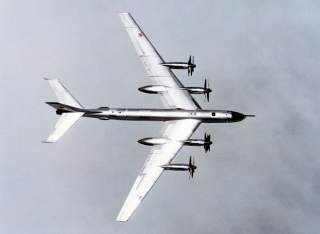Watch Out: Russia's Getting a 6th Generation Stealth Bomber
A real problem?
Key point: Moscow wants to be able to compete with the sixth generation weapons America is building.
As the Su-57 fifth-generation fighter moves into serial production in much larger quantities than previously expected, reports are emerging that the Russian defense establishment has their eyes trained on a “sixth-generation” strategic stealth bomber.
At the 70th anniversary of the Zhukovsky Test Flight and Development Center, Tupolev CEO Alexander Konyukhov said that there are "There are big plans ahead for testing and further developing the heavily upgraded Tu-22M3M, Tu-160 and Tu-95MS aircraft along with large-scale work for testing the prospective complex of long-range aviation [PAK DA].”
Russian state news reports that the PAK-DA, as the bomber is currently known, will undergo initial testing at the Zhukovsky Center. Perhaps the most striking aspect of the PAK-DA is how close the fighter is to entering service within the Russian Air Force (VKS)-- according to then-Deputy Minister of Defense Yuri Borisov, the first prototype is expected in 2021-2022, the maiden flight is scheduled for 2025-2026, and serial delivery will begin in 2028-2029.
Needless to say, this timeframe should be taken with a warranted degree of reservation; from the S-500 to the Su-57, this wouldn’t be the first flagship Russian military hardware project to languish in a cycle of overeager estimates followed by cyclical delays (nor is this phenomenon exclusive to Russia’s military-industrial complex).
Whereas Russia’s current crop of heavy, strategic, nuclear-capable bombers is entirely composed of Soviet-era fighters and iterations thereof, the PAK-DA will be based on a completely new design-- as lead engineer Igor Shevchuk put it, a “fundamentally new fighter, based on new conceptual solutions.” As United Aircraft Corporation (UAC) President Yuri Slyusar added, “we, of course, are talking about a serious reduction in observability, improved handling, and expanded combat capabilities.”
Little is currently known by way of PAK-DA’s concrete specifications. Russian defense commentary suggests a possible operational range of 12,000 kilometers, a payload of up to 30 tons, and subsonic flight speed. The latter fact is particularly important in light of VKS commander Viktor Bondarev’s clarification that the PAK-DA prioritizes “stealth capabilities” over raw speed: “It is impossible to build a missile-carrying bomber invisible to radars and supersonic at the same time. This is why focus is placed on stealth capabilities. The PAK-DA will carry AI-guided missiles with a range of up to 7,000 km. Such a missile can analyze the aerial and radio-radar situation and determine its direction, altitude and speed. We’re already working on such missiles.” These missiles, which can purportedly switch targets in mid-flight and autonomously adjust their flight path to evade radars, are still under development, and-- given Bondarev’s emphasis on stealth-- will almost certainly be stored in the PAK-DA’s internal weapons bay.
The PAK-DA is being branded as a replacement to the Tu-160 and Tu-22M3, but is unlikely to be mass-produced in sufficient quantities to become the backbone of Russia’s strategic bomber force. Russia’s defense establishment has recently confirmed that the Tu-160 and Tu-22 designs are here to stay for the foreseeable future, as both are getting avionics, quality of life, and armament suite refreshes in the form of the Tu-160M2 and Tu-22M3M respectively. Instead, it appears that the PAK-DA is designed to fill a high-intensity, deep penetration, nuclear conflict niche against the world’s leading air defense systems.
Mark Episkopos is a frequent contributor to The National Interest and serves as research assistant at the Center for the National Interest. Mark is also a PhD student in History at American University. (This first appeared in early August 2019.)
Image: Wikimedia.

